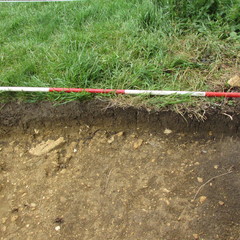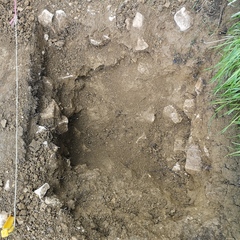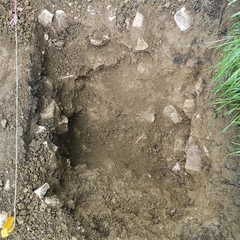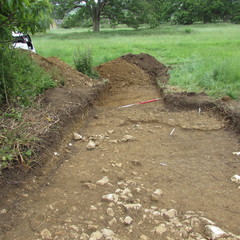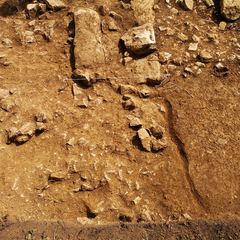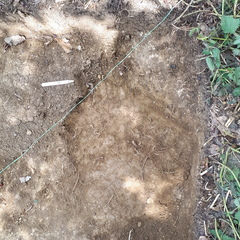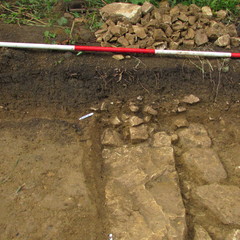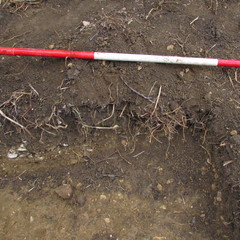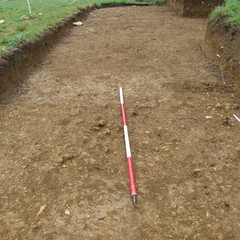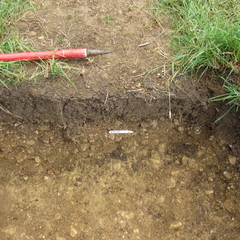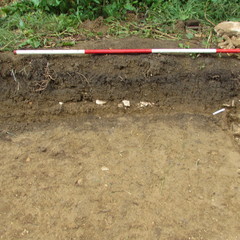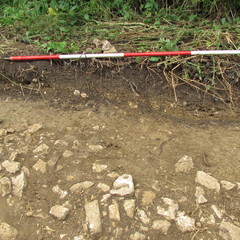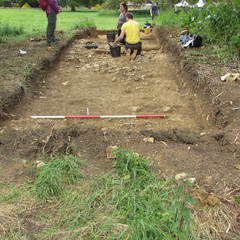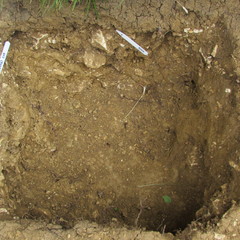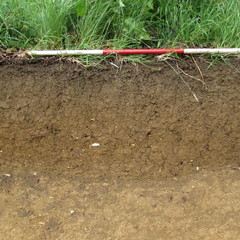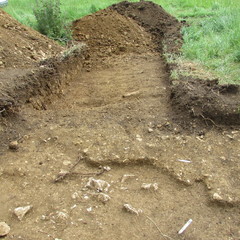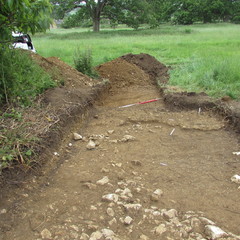- Trench 7.
Photos
- No Files Attached
- Trench 7 Trench 7 was 18.50m x 3m wide aligned north to south with a trench extension 19.50m x 3m aligned east to west. The trench targeted an anomaly in the form of mound identified from an archae-topographical and magnetometry survey in 2014 (Fradley et al). The trench was excavated by machine to the top of three cut archaeological features and a raised platform that were not indicated in the archae-topographical and magnetometry survey. The platform appears to be made up of a series of constructed layers classified in this assessment as features contiguous with trench 6 to create a flat platform along with two possible structural walls, a possible floor and a stone drain set within it. All the features are likely to represent one single large construction event partially removed by probable robber trenches relating to Canon Lyson’s excavations of the mound in 1875. The earliest feature in the trench is an artificial surface construction of redeposited sub-soil (ratch) (F701) similar to Trench 6 and likely to be contemporaneous. It was visible in the section of a stone drain (F702). On top of this was a hardcore surface probably acting as a cap (F706) constructed of a yellowish-brown sandy clay with medium sub-angular stones moderately sorted. A sherd of Coarseware 1 dating from the 16th to18th century could relate to the construction of the hardcore cap if it is in the lower end of the range. 7.4.3 This was then capped with another surface of brown clay (F707) again as an apparent waterproof layer. In this cap was a light-bodied salt-glazed stoneware sherd which could be a 16th-century Rhenish stoneware or something much more modern. One sherd of 16th century pot was also retrieved and two small 18th-century creamware sherds. If the two creamware sherds from the clay surfaces are also associated with the structure they can be discounted as intrusive, which gives late medieval date/early post-medieval date for the structure as possible but not certain. A musketball was recovered that is possible evidence of the civil war sieges at Sudeley in 1642 and 1644 which makes sense given that the cap was the last construction phase of the Tudor garden extension which went into disuse in 1649 when Sudeley was slighted. The brown clay cap of the platform appeared to abut a wall (F703, or the wall was set into it, the relationship is not clear. In the fill were two fragments of leaded glass that could relate to a projecting bay or oriel window. One fragment appears to be stained glass. They were found in an area where a possible floor appears to have been cut away from the wall (F703) by a robber trench (F705). There were also five sherds of pottery probably dating to the 16th century in it which could indicate its construction date. An 18th century sherd is probably invasive. Together these surfaces formed a raised flat platform with two probable walls that appear to be set into it (F703, (F710) forming a possible building that may be contiguous with the construction of the platform. The first wall (F703) was located at the east of the trench measuring 0.79m wide on a north to south alignment composed of frequent large and medium angular stones and yellowish-brown sandy clay. The wall contained two distinct layers of compacted stone bedding one of large stones as foundation with a top course of medium stones. It is not clear if the wall was part of a banqueting house structure or a joining wall between two potential banqueting houses linked by a walkway. A decorated stone with a rose was found in the fill of the stone wall (F703) along with another two were three carved architectural fragments. The wall foundation contained a very abraded sherd dating 11th to13th century probably residual possibly from the underlying ratch. The fill of stone wall also contained a single bone fragment that could only be identified as medium mammal. Another carved stone rose was found in a rubble layer (F709) adjacent to the wall. In the rubble layer were also ecclesiastical type sculpted architectural fragments including two curved facing stones, a projecting bay or oriel window with small holes probably for vertical glazing bars holding stained glass or a leaded window. The windows would usually be in a set arranged together in a bay protruding out braced by brackets or corbels. Bay windows are on a ground floor and oriel windows on the first floor. Also, in this deposit was rounded probable projecting window supporting corbel and a rounded and ribbed half mock column corner stone which is from a very narrow column joined to the corner. A further find was a small roof tile with chamfered sides and mortar with a broken rounded hole for attachment that is likely to relate to a small roof over the oriel window. They exactly match stones from the Sudeley Castle display vault of Winchcombe Abbey stones and voila (Figure 7). The rubble appears to have collapsed from above and wedged into the clay at either side of the wall. These fragments are indicative of collapse and a period of abandonment of a possible building. The multiple fragments of carved and decorated stonework along with the two fragments of glass denote a high-status building. The stones are similar to those found in a drain (F702) which may contain stones removed in January 1547 by Thomas Seymour when he took possession of Winchcombe Abbey (Derek Maddock pers comm). Some of the stone could have also come from Hayles Abbey dating to 1321 (Derek Maddock pers comm). All of the stones appear to have an ecclesiastical styling indicating that a building was constructed from re-used stone which could conceivably relate to a banqueting house. A fragment of leaded glass was found at the interface of the topsoil and the rubble which could be the original leaded glass of the possible banqueting house corner projecting bay or oriel window remaining from a period of disuse and collapse. The trench was then extended a further 3m to reveal a probable second wall (F710) 0.60m wide located parallel to the first wall on the same alignment. It appears to have been removed by a very indistinct probable robber trench from Canon Lyson’s excavations probably running probably north east to south west (F705). This wall was unexcavated but also appeared to be composed of frequent large angular stones filled with a similar yellowish-brown sandy clay. The similar construction suggests contemporaneity and the fact that it is parallel with the first wall suggests that the two walls are part of a possible building structure. The fills of both walls are also very similar to the hardcore cap (F706) and the re-deposited surface underlying (F701) which suggests that the walls are contemporaneous and were constructed at the same time as the platform. A possible floor (F708) was located at the east of the trench made up of a compact layer of yellowish-brown sandy clay with frequent small stones. The floor was on top of the clay cap located between both walls and was probably constructed at the same time or shortly after. The floor appears to have been cut away by the same robber trench (F705) from Canon Lyson’s excavation. It abutted the second wall (F710) and it possibly represents a floor on the inside of the building. The compact floor layer may have been covered with either stone flags, possibly laid directly on a compacted base or ceramic tiles with a ‘cement’ fixing probably a lime mortar or types of clay which may well have all been robbed out. The clay cap underneath the robbed-out floor contained the remains of cattle, a galliform bird probably domestic chicken or common pheasant and conger eel. Evidence of feasting perhaps. A stone drain (F702) was linear in plan aligned east to west located at the north of the trench with steep sides and a slightly concave base 0.60m wide and 0.40m deep filled by silty clay with frequent stones (7007). It was packed with architectural fragments. Three were sculptured and painted and one stone had a stone masons mark in the form of a ‘W’ dating to 1420. The same mark is found on other fragments from in St Peter’s in Winchcombe in the old part of Sudeley Castle (Marion Littlejohn pers comm). The mason’s marks are recorded in John Steinson’s Winchcombes Mason’s c1200 – 1500 Research Paper 2nd and enlarged version probably relating to stones removed from Winchcombe by Thomas Seymour (Derek Maddock pers comm). It is likely that the stones were re-used to fill the drain. A pot sherd dating 12th to 13th century were also discovered but was abraded and may well be residual. The stratigraphical relationship of the drain is not clear. It appears to be under the cut of a robber trench (F704) and possibly constructed through the hardcore cap and through the underlying layer of ratch surface. It is more likely that that the layer of the hardcore cap originally abutted the drain and that it is contemporaneous. It appears to be a soak away probably constructed to drain the garden on an east west alignment running inside the northern boundary walkway of the garden. At the south of the trench was a garden bank (F711) indicated on the LiDAR survey and appears to be a direct correlate (Fradley et al, 2014). This was also covered by the hardcore and brown clay caps. There were two possible robber trenches from Cannon Lyson’s 1877 excavation. They could have been in the form of an ‘L’ shape dug east to west and then north to south at a right angle robbing out most of the probable building including the floor. The alignments are not clear and they are more likely to represent one continuous robber trench on a north west to south east alignment (Figure 3). They are indicated by the presence of a very fine sieved soil but the edges of the cuts are fairly indistinct suggesting the trenches was fairly shallow. The cut of the first trench (F704) was linear in plan with a very gradual break of slope at the top with gently sloping sides and a concave base measuring 5.20m long, 3.00m wide and 0.20m deep. It was filled with very fine sieved silty sand. It appears to have cut away the clay cap leaving a small remnant and reduced the level of the hardcore cap. The backfill of the trench included sculptured architectural fragments in the form of a rounded and ribbed mock half column corner stone which is from a very narrow internal column joined to the corner and vertically chamfered internal decorative stones. The chamfered stones are carved and would have stood upright vertically internally in the structure with the chamfer for decoration. Horizontal stones would not have a flat edge as the imperative is always for them to shed water and control its flow. The chamfered stones are an indication of a high-status building. The architectural fragments were sitting on top of the reduced hardcore cap and may well have been left behind from Lyson’s excavations. The edges of the trenches are fairly indistinct but the trench appears to continue east and the mound looks severely reduced extending back to the east. The fill contained one sherd of pot dated 12th to13th century with a thumbprint sitting on a residual element of the clay cap. This could be residual but it was unabraded and along with the stone could possibly indicate the survival of medieval deposits underneath the platform even relating to a possible Manor House. The cut of the second trench (F705) was also linear in plan with a very gradual break of slope top with gently sloping sides and a concave base 6.30m long, 3.00m wide and 0.05m deep. It was also filled with a very fine sieved silty sand. The robber trenches represent the last event in the stratigraphic sequence. The rubble spreads indicate that the building was already in a state of collapse long before it was robbed. The survival of architectural fragments to the west of the first wall suggests a period of disuse and collapse of a building. Test pits 2 and 5 were positioned over the mound. Test pit 2 was just outside of the excavation area to the north and was dug to a depth of 0.94m revealing a raised bank with a line of stones observed in the section that were roughly dressed. The fill was very mixed indicating that it was probably backfill from Canon Lyson’s previous excavation. Test pit 5 was within the trench and dug to a depth of 0.56m revealing revealed layers likely to be contiguous with the clay cap and hardcore cap. The test pits results broadly corresponded with the results of the previous earthwork and magnetometry survey indicating the existence of a raised platform possibly relating to a Tudor Garden and possible banqueting house. The vertebrate and marine mollusc remains recovered during test-pit and archaeological excavations in 2018 and 2019 include some of the main domestic livestock species in Britain from the Iron Age to recent times; cattle, pig, sheep/goat and goose. The remains of these animals provide evidence for the rearing or consumption of beef, pork, lamb/mutton and goose (meat/eggs/feathers) in the vicinity of Sudeley Castle. The remains of a domestic dog or fox could not be distinguished, but either species are not unexpected in archaeological deposits of the nature of those encountered at Sudeley Castle. These demonstrate that a wide range of dietary resources were exploited at and/or in the vicinity of Sudeley Castle with some evidence for the utilization of marine resources at this inland site. The results from Trench 7 indicate that the mound appears to relate to the remains of a Tudor raised garden platform with a possible banqueting house constructed on top. It was made up of a series of constructed surfaces consisting of ratch with a hardcore and clay cap with two structural walls pertaining to a building with a probable floor with a possibly contemporary drain, along with garden banks serving as garden bed borders. It would appear to have been purposefully constructed contemporaneously as an element of a Tudor garden extension representing one large scale construction event in the 1570’s. The building structure then goes through a process of collapse which was then robbed out by an antiquarian excavation in 1877 by Canon Lyson funded by Emma Dent. These trenches appear to have removed approximately half of the mound. It is still possible that there is a Manor House underneath the raised platform but it could be that was discovered is a later building possibly a banqueting house.
3-D Models
- No models found for this item
Plan
-
Plan: sud_7
- Plan of trench 7 and strat not to scale
- Stuart Noon
- 24-7-2019
Section
- No records attached.
Features
-
Feature: SUD_701
- Light reddish-brown silty sand with occasional medium and mod sub-angular stones poorly sorted
-
Feature: SUD_702
- Cut [7006] of drain that had a sharp break of slope at the top with steep sides and a slightly concave base measuring .80m wide and 3.00m long within the trench. It was filled by reddish-brown silty clay with frequent small and medium stones some sculptured (7007).
-
Feature: SUD_703
- Wall measuring 0.72m (N) - .79m (S) long and 3.00m wide on a north to south alignment. It was composed of frequent large and medium very angular stones (7011) filled with a light yellowish-brown sandy clay (7009).
-
Feature: SUD_704
- Cut of east to west robber trench [7014] which was linear in plan with a very gradual break of slope at the top with gently sloping sides and a concave base measuring 6.30m long to the limits of excavation and 3.00m wide. It was filled with very fine sieved mid grey silty sand (7003).
-
Feature: SUD_705
- Emma Dent’s 1877 excavation running north to south
-
Feature: SUD_706
- Hardcore cap
-
Feature: SUD_707
- Clay cap
-
Feature: SUD_708
- Probable floor
-
Feature: SUD_709
- Rubble layers
-
Feature: SUD_710
- Robbed out wall
Contexts
-
Context: SUD_7001
-
Context: SUD_7002
-
Context: SUD_7003
-
Context: SUD_7004
-
Context: SUD_7005
-
Context: SUD_7006
-
Context: SUD_7007
-
Context: SUD_7008
-
Context: SUD_7009
-
Context: SUD_7010
-
Context: SUD_7011
-
Context: SUD_7012
-
Context: SUD_7013
-
Context: SUD_7014
-
Context: SUD_7015
-
Context: SUD_7016
-
Context: SUD_7017
-
Context: SUD_7018
-
Context: SUD_7019
-
Context: SUD_7020
-
Context: SUD_7021
-
Context: SUD_7022
-
Context: SUD_7023
-
Context: SUD_7024
-
Context: SUD_7025
-
Context: SUD_7026
-
Context: SUD_7027
-
Context: SUD_7028
- Stuart Noon 21-5-2019


